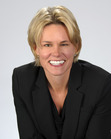Molly Fletcher's Blog, page 13
May 2, 2017
100 Days of Fearlessness
 In celebration of my new book, Fearless At Work, we hosted a #FearlessLiving contest and encouraged people to share their stories of inspiration. So many of you shared amazing stories with us, and we are very excited to announce that Kandi VanIperen is our grand prize winner and will be joining us at Leadercast in Atlanta this week!
In celebration of my new book, Fearless At Work, we hosted a #FearlessLiving contest and encouraged people to share their stories of inspiration. So many of you shared amazing stories with us, and we are very excited to announce that Kandi VanIperen is our grand prize winner and will be joining us at Leadercast in Atlanta this week!
Kandi shared how she embarked on a 100 days of fearlessness challenge, where she and her friends encouraged each other to get out of their comfort zones and break through the status quo by completing daily challenges. Her story really embodies how little moments of fearlessness can create big outcomes as she used her newfound confidence to start a new career in the process.
Here is Kandi’s story in her own words.
Stay fearless!
————————————————————————————-
Have you ever felt like you were on auto pilot? Like each day was routine, unengaging, and stagnant. Well that was how I was feeling most days of the week at this same time last year.
Along with my friend, Heidi, we started a group called 100 Days of Dares. The idea was simple; dare each other and our friends to do one new thing each day for one hundred consecutive days. It was a silly idea but we ran with it. It was cozy at the start with about 20 of our friends and coworkers doing little fun things like trying new foods and recipes. Soon people were inviting others and we got braver and started pushing the limits.
 The best part was that the challenge was personal. Each person dared themselves to do new things that excited them, motivated them, pushed them, and scared them. This created a wide range of new adventures to be shared and limitless new ideas to what could be tried. Because it was individualized, it inspired each member of the group (now over 100 members) in different ways. We saw people make things and break things, wear wigs and not wear make-up, try new activities and revisit old hobbies, perform random acts of kindness, face fears, and travel to new places all across the country.
The best part was that the challenge was personal. Each person dared themselves to do new things that excited them, motivated them, pushed them, and scared them. This created a wide range of new adventures to be shared and limitless new ideas to what could be tried. Because it was individualized, it inspired each member of the group (now over 100 members) in different ways. We saw people make things and break things, wear wigs and not wear make-up, try new activities and revisit old hobbies, perform random acts of kindness, face fears, and travel to new places all across the country.
The small moments that we started with turned into opportunities each week to do more, and resulted in even bigger outcomes by the end of the summer. For Heidi, it was a new perspective on life and stronger connection with her children (some of them even did the 100 days of dares with her). For me, it gave me the courage to quit my job of almost 10 years and say yes to a new career in a new industry. We became more fearless and less hesitant. As opportunities arise, we take on the challenges and inspire those around us in our group to do the same. We have already started another 100 Days of Dares for 2017 and are excited to see what everyone aspires to do next.
 We believe it’s never too early or too late to start trying, doing, and living more. Start small. If you are about to order the same menu item from the same restaurant as you always do, stop yourself and try something new. If someone asks you to do something a bit crazy like go kayaking down the flooded street, say “Yes” like I did. If you want to have a food fight just because, then invite your friends over and do it. The most important thing, simply, is to start. Be fearless and say yes to more! You never know what it will prepare you for later.
We believe it’s never too early or too late to start trying, doing, and living more. Start small. If you are about to order the same menu item from the same restaurant as you always do, stop yourself and try something new. If someone asks you to do something a bit crazy like go kayaking down the flooded street, say “Yes” like I did. If you want to have a food fight just because, then invite your friends over and do it. The most important thing, simply, is to start. Be fearless and say yes to more! You never know what it will prepare you for later.
————————————————————————————-
Molly Fletcher helps inspire and equip game changers to dream, live and grow fearlessly. A keynote speaker and author, Molly draws on her decades of experiences working with elite athletes and coaches as a sports agent, and applies them to the business world. Her new book, Fearless At Work, is now available for order. Sign up here to receive our monthly newsletter.
The post 100 Days of Fearlessness appeared first on Molly Fletcher.
April 24, 2017
3 Ways to Build Better Business Relationships
 Business relationships can often be improved. Especially in leadership and sales, the difference between good and great can be better business relationships. Nurturing these important connections doesn’t just happen. You have to be intentional and commit to the long haul.
Business relationships can often be improved. Especially in leadership and sales, the difference between good and great can be better business relationships. Nurturing these important connections doesn’t just happen. You have to be intentional and commit to the long haul.
Here are three time-tested ways that work. These are concrete steps that help you observe and absorb what makes a person tick. These strategies will help you relate authentically, which is the key to building stronger relationships.
1. Give. Great relationships are cultivated by consistent giving. Start by asking: How can you help your most important business contacts—those you already have and those you want to gain? Your answer to that question, and your follow-up actions, will create a place to start adding value.
Some examples:
Introducing them to a person in your circle who can help them in some way.
Forwarding valuable industry-specific news or leads; look for sources that your contact is not tapping.
Pointing them to books and articles that could advance their goals.
Providing knowledge, access or assistance that they cannot easily secure otherwise.
The mindset is always about the other person, not about you.
As an agent, I had to build relationships with key players so they would choose me to represent them. Giving authentically was crucial. My mindset and behavior was built around the idea of, “How can I act like I have the business before I have the business? How can I give and give and give so that this player thinks, they don’t represent me yet and look all they are doing for me?”
The more your empathy guides your thoughts and actions, the more you will project positivity to this important contact. Give without expectations of receiving something in return. An authentic value add is built by focusing not on your gain, but the other person’s.
2. 360-Degree Awareness. This is what I call a commitment to knowing and absorbing everything you can about a person who is significant to you. It starts by knowing the goals, needs, gaps, values and fears of the person.
As an agent, I practiced role playing daily, imagining that I was each player and asking myself: What am I worried about? Excited about? Anticipating? Fearing? Questioning? This practice helped me be aware of what they were facing and be prepared for what they might need, want and appreciate right then.
Everyone has inner baseline—they often hold values beyond money or status that give them purpose and meaning. In negotiations, being 360-Degrees Aware is critical to reaching a mutually beneficial agreement. It is a mindset that opens you to key details that reveal these values, and to understand the person’s role models and other influential relationships.
3. Anticipate Key Moments. This ability to think ahead is huge. It separates people who are transactional (What can I get from this person?) to those who are relational (What can we give each other?) Anticipation can be recognizing a key moment- an upcoming work anniversary, professional honor, or career change. Or it can be anticipating the next interaction and thoughtfully crafting your approach to honoring the other person’s time and values.
By investing your time and energy in advance, you send a powerful signal of how much you value a relationship. You are no longer reactive but proactive.
There’s always excitement when you land a meeting with a great prospect. But the key moment isn’t landing the meeting; it’s the moment when the meeting ends and the person returns to their world. At that point, your story is brand new: Will we show this important person that we meant what we said? That we will do what we said, that we truly want their business and that we are authentic and will always follow up?
Don’t miss these key moments. Anticipate them.
Your Game Changer Takeaway
These three methods (Giving, 360-Degrees Awareness, Anticipate Key Moments) involve taking some risks because you are going to work differently to gain a closer relationship and understanding of the other person. There is risk of rejection, and working through that will build your fearlessness. Better business relationships—the ones that are close, authentic and mutually beneficial—are worth the extra work.
M olly Fletcher helps inspire and equip game changers to dream, live and grow fearlessly. A keynote speaker and author , Molly draws on her decades of experiences working with elite athletes and coaches as a sports agent, and applies them to the business world. Her new book, Fearless At Work , is now available for order. Sign up here to receive our monthly newsletter.
The post 3 Ways to Build Better Business Relationships appeared first on Molly Fletcher.
April 17, 2017
How to Build a Resilient Mindset with 9 Visualization Techniques
 It’s been an amazing year for comebacks and underdogs—the Chicago Cubs and Cleveland Cavaliers (both in Game 7), Clemson in the national football championship, North Carolina in the Final Four, and Sergio Garcia in the Masters.
It’s been an amazing year for comebacks and underdogs—the Chicago Cubs and Cleveland Cavaliers (both in Game 7), Clemson in the national football championship, North Carolina in the Final Four, and Sergio Garcia in the Masters.
They all have stories of being resilient enough to bounce back from adversity quickly. This is how leaders in business and sports distinguish themselves. They don’t wait for the next unexpected challenge, and you don’t have to either. Start practicing now to help you bounce back quicker when you need to.
Visualizing resiliency is the key, PGA Tour star Billy Horschel told me in an awesome podcast conversation recently. Billy offered great insight into how the best move super quickly from setback to comeback. These are tips he has gained from watching and talking to Tiger Woods, Jordan Spieth and others. He’s applied them to situations like losing his PGA Tour card and battling back to become the youngest winner of the FedEx Cup.
Rehearse the Right Mental Images
It starts with great mental preparation. Like his peers, Billy spends time visualizing executing his best shots, hearing the gallery applause, holding the trophy, and giving interviews. He also programs his mindset for great recoveries by doing the following.
1. Visualize overcoming obstacles. Give yourself a clear picture of your ability to pick yourself up. Billy imagines himself grinding out a good score after a poor start, knowing that the capacity to do that is critical to his long-term success in pro golf.
2. Make the obstacles specific. Billy mentally rehearses saving par from 40 yards away from the hole, for instance.
3. Limit self-criticism. It’s easy to beat yourself up for a mistake; top performers spend very little time in this space. “They are fully invest in the next shot and they let the past be bygone,” Billy says. After a miss, the best quickly shift into preparing for the next best step.
4. Practice patience. Billy echoed my longstanding belief that success rarely if ever happens all at once, and building this mindset is key to picking yourself back up. “You’re not going to have everything be easy and successful right away. Billy says.
5. Collect memories of success. When you practice mentally, you have already reminded your brain of its capacity for success. This powerful practice is transferable to other challenges. “Whether you are meeting quarterly sales numbers or playing golf, you have got to envision yourself as being successful, then you can be successful in reality,” he says.
6. Relax. When you’ve prepared as well as you can physically and mentally, you deserve to perform well and bounce back quickly. Relaxing helps Billy let all of the preparation and self-belief flow into his golf game so he can focus on being present.
7. Manage expectations. To control his emotions, Billy tries to play without expectations. He follows the process of preparing as well as possible and staying present. The more he claims this as his mindset, the more likely the low numbers will follow. “If you believe in yourself, you can conquer anything,” he says.
8. Give yourself positive feedback. When you battle through adversity, remind yourself that you can do it. “I can say I have handled the good and the bad,” Billy says. Failure is simply feedback.
9. Find what works for you. After picking the brains of Tiger Woods and many others known for their strong mental games, Billy takes one or two points “and molds it into what works for me.” Makes sense, because none of us are carbon copies.
Your Game Changer Takeaway
Top performers recover fast, and these tips from Billy Horschel are a great way to practice bouncing back in advance of your next challenge. By rehearsing your reaction to adversity, you will own the mindset to recover quickly from defeat in real time, and be better poised to handle change.
M olly Fletcher helps inspire and equip game changers to dream, live and grow fearlessly. A keynote speaker and author , Molly draws on her decades of experiences working with elite athletes and coaches as a sports agent, and applies them to the business world. Her new book, Fearless At Work , is now available for order. Sign up here to receive our monthly newsletter.
The post How to Build a Resilient Mindset with 9 Visualization Techniques appeared first on Molly Fletcher.
April 10, 2017
5 Things Fearless People Do
 Change is all around us every day, and inside uncertainty is where fear can take hold. When we don’t know what’s ahead, we easily can fill our small moments with things that comfort instead of challenge us.
Change is all around us every day, and inside uncertainty is where fear can take hold. When we don’t know what’s ahead, we easily can fill our small moments with things that comfort instead of challenge us.
My new book, Fearless At Work, is out today. In it, I share how to trade fear for more productive behaviors to maximize potential. Fearlessness is about the 1,440 minutes we have each day, and what happens when we recognize their power. It’s about the small yet intentional choices we make to create big outcomes.
It’s about realizing that inside of every moment, we have a choice. And we can choose fearlessness.
Today is a great time to choose habits that build fearlessness! Here are five things that fearless people do, that you can too.
1. Get clear on their purpose. At the heart of fearless living is a sense of purpose. If you don’t have a clear purpose, you are more likely to sacrifice your time, energy, and resources to the wrong things for the wrong reasons. A strong purpose suffocates our fears and serves as our compass when we feel fear and doubt begin to creep in.
2. Demonstrate curiosity. Curiosity asks the question: “what’s possible?” Where other people see obstacles, fearless people see opportunity. Imagine if you shifted your lens to filter the world not through fear, but through curiosity instead. What possibilities would you open yourself up to?
3. Take ownership of their story. When you are fearless, you understand that you are the boss of you right now. You own your thoughts and your actions and that means taking ownership of the story you tell yourself. Our old story is all about but… “I would love to do that, but…” Your new story trades all those buts for who you want to be most. Fear makes excuses; fearless people make a habit of accountability.
4. Practice resilience. It’s natural for us to fear pain and failure; those are paths to strength and resilience for fearless people. They make a habit of trading short-term pain for long-term growth and view failure as just another form of feedback. Fearless people recognize that resiliency is sometime as simple as showing up when it’s the last thing we feel like doing.
5. Take bold action. Inside of each day, we have 1,440 minutes. Fearless people maximize those little moments by leaning into discomfort and taking calculated risks. They know that fearlessness isn’t just a mindset; it’s about taking action. Fearlessness is being bold in the little moments life presents us each day, that lead to big outcomes. And by being bold, we inspire fearlessness in those around us.
Your Game Changer Takeaway
Pick one of these five behaviors to focus on—for the next 5 days or 5 weeks or forever. For more inspiration, check out Fearless At Work to strengthen your own fearless muscle and inspire others.
M olly Fletcher helps inspire and equip game changers to dream, live and grow fearlessly. A keynote speaker and author , Molly draws on her decades of experiences working with elite athletes and coaches as a sports agent, and applies them to the business world. Her new book, Fearless At Work , is now available for purchase. Sign up here to receive our monthly newsletter.
The post 5 Things Fearless People Do appeared first on Molly Fletcher.
April 4, 2017
My #Fearlessliving Story
What’s your #fearlessliving story? Share it to enter our contest and you may win an all-expenses paid trip for two to Leadercast 2017.
A decade ago, the part of my “dream job” as a sports agent that I loved the most was taking a raw relationship with an athlete or coach, and building a deep connection. I loved the challenge of gaining deep trust that led to them signing with us and us supporting their peak performance. I had to pinch myself those times, for instance, when an athlete called me from the hospital when his wife had a baby, or when we celebrated a new contract together. I loved serving as a lifeline to their careers and families, and so many young people asked me for career advice that I wrote what I knew and published my first book.
The book led to a couple speaking gigs. In front of a crowd, I felt my energy rise to the same challenge to connect, only this time with an audience. The idea of reaching more people—to connect, inspire and lead with creative courage and optimism—bubbled up. My family agreed to support my reinvention, believing I could take what I loved the most about the agent space—helping people achieve their potential– and do it in a bigger way. When I made the decision to shift, I had published two books and had spoken probably a half dozen times to corporations. Even though the road ahead wasn’t crystal clear, all those years around pro athletes and coaches had taught me that great success comes from going all in. So I did!
Today my work is all about what I love most. Every week I meet new audiences seeking peak performance, with very limited time to build trust and authentic connection. Meeting this challenge creates fantastic energy that affirms my purpose. I was scared when I made the jump. It was new and different but in my mind it was the same work with a different impact – connecting, supporting and inspiring peak performance. Fearlessness is about feeling the fear and doing it anyway.
My #fearlessliving story makes me so grateful for those small moments of connection that can create a big outcome for any and all of us!
Molly Fletcher helps inspire and equip game changers to dream, live and grow fearlessly. A keynote speaker and author , Molly draws on her decades of experiences working with elite athletes and coaches as a sports agent, and applies them to the business world. Her new book, Fearless At Work , is now available for pre-order. Sign up here to receive our monthly newsletter.
The post My #Fearlessliving Story appeared first on Molly Fletcher.
March 27, 2017
A Secret of How Great Leaders Hire
 Is hiring the right people strictly a matter of talent? That’s not how great leaders think, and neither should you. Knowing that every personnel decision can make or break your team’s success, let me share a secret of how they hire that will change the way you approach filling important roles on your team.
Is hiring the right people strictly a matter of talent? That’s not how great leaders think, and neither should you. Knowing that every personnel decision can make or break your team’s success, let me share a secret of how they hire that will change the way you approach filling important roles on your team.
For my recent podcast, I spent time with Verne Harnish, founder and CEO of Gazelles, a global executive education and coaching company, and author of “Scaling Up: How a Few Companies Make It… and Why the Rest Don’t.” What Verne shared about hiring really hit home with me.
“We always talk about what you need to do and be to be a great leader,” Verne pointed out. “We don’t talk enough about the ideal team player. What do you have to do to be a great team member?”
And most important: how do you identify and hire that person?
Traditional criteria are backward
Traditional leaders hire on four criteria in this order:
Skills
Results
Values
Will
Makes sense, right? We have to determine whether the person has the skills and has produced the results that we need on our team. Those need to be first, and if those are in place, we often skip the values and will. Sometimes, there’s not enough time or desire to dig that deep. We have to get to work.
Great leaders flip this process, Verne says. By doing so, they identify and hire the people who have the desire and principles to achieve beyond their résumés.
Here’s how and why.
Will is the foundation. The team member has to want to achieve and do a great job. “It’s tough to coach someone to have the will to taste success,” Verne says. Will is the engine for great performance.
Values drive greatness . When the job candidate’s values align with the values of the organization, they are invested in the work as a reflection of what they care about. This connection drives productivity.
Results are important for assessing potential. “Look for the pattern of what the person grabs hold of, even back to high school,” Verne says. “Did they just achieve, or did they super achieve?”
Skills are most significant in context. Because technology and work is changing so quickly, a great leader focuses on the job candidate’s ability to adapt existing skills. Not just have those skills.
Other thought leaders agree that we have to move beyond conventional ways of hiring.
Seth Godin recently wrote about the misperception of soft skills . “It turns out that what actually separates thriving organizations from struggling ones are the difficult-to-measure attitudes, processes and perceptions of the people who do the work.”
Great leaders fearlessly go against traditional thinking to choose the right people to join their teams. “This takes guts, because it feels like giving up control, but we never really had control in the first place. Not if we’ve been obsessively measuring the wrong things all along.”
That’s how great leaders hire.
Your Game Changer Takeaway
Great leaders know that the inner fire of their team members is more important than a list of their past successes. Improve your leadership by fearlessly prioritizing a job candidate’s will and values and considering skills and results in context. You’ll be hiring someone you can count on and coach to even greater success, to the great benefit of you and your team.
M olly Fletcher helps inspire and equip game changers to dream, live and grow fearlessly. A keynote speaker and author , Molly draws on her decades of experiences working with elite athletes and coaches as a sports agent, and applies them to the business world. Her new book, Fearless At Work , is now available for pre-order. Sign up here to receive our monthly newsletter and subscribe to our podcast , Game Changers with Molly Fletcher.
The post A Secret of How Great Leaders Hire appeared first on Molly Fletcher.
March 21, 2017
Are These Types of Clutter Holding You Back?
 The new growth of springtime can inspire us to start something new. And it’s so much easier to do our best work when we get rid of clutter.
The new growth of springtime can inspire us to start something new. And it’s so much easier to do our best work when we get rid of clutter.
Spring cleaning isn’t just for your home; now is a great time to clear out the other kinds of clutter taking up valuable space in your head and heart.
To mark the start of this new season, here are 10 questions to help you get started with your most purposeful de-cluttering.
Physical clutter: How do you decide what to get rid of? It’s not easy, because we assign meaning to most everything around us. Try using this definition from my friend Tommy Newberry: “Clutter is anything that adds to the complexity of your life without increasing your peace of mind or bottom line. Often it is a byproduct of past mistakes, unwise decisions, or disorganization. Sometimes, though, it is the result of being productive, like the mess left behind after successfully cooking a gourmet meal.”
1. What is one thing you can remove from your life today?
2. How will its absence increase your peace of mind or bottom line?
Mental clutter. This haphazard, unmindful thinking is even more detrimental than extra stuff or boxes in your office or home. The clutter you cannot see can be much harder to get rid of. Mental clutter can be procrastination, complexity, disorganization, unfinished business, over-commitment, busy work, spam, and resistance.
3. What is one recurring situation for you in which the urgent overrules the important?
4. How will you change that today and benefit by doing what is most important instead?
Spiritual/soul clutter: Distractions are everywhere for all of us, and it’s so important to clear the way to do the best we can with the time and opportunity that we have. Try setting a small ritual to quiet the noise. For me, that means a meditation and 30-minute workout before I hit the stage for a keynote. Some of my other small clutter-clearing rituals include yoga, walking the dog, and attending Mass. These activities help me cut through the clutter.
5. What can you start practicing today to cue your focus and help you relax for peak performance?
6. What will you need to adjust/implement/give up to make that happen?
Relationship clutter: Like the piles of stuff around us, it’s easy to let our relationships get mired in unhealthy communication. The best way to pierce this kind of buildup is with honest vulnerability and curiosity.
7. What relationship and/or issue will you get clear on today through honest questioning and listening?
8, What’s standing in your way?
Schedule clutter: This is where a personal mission statement can create more time and meaning for you. It is a lens that you use to look closely and critically at your calendar, and become relentless in protecting your time as a nonrenewable resource. This type of de-cluttering led me to the small but powerful step of no longer automatically accepting meeting requests.
9. Where do you need to spend more of your time today?
10. What do you need to say no to? (Because when we say “no” to one thing we are saying “yes” to something else).
Your Game Changer Takeaway
Clutter in our lives is a signal to let go. It is the evidence of what you do not have room for. It’s what you don’t need to do, have or be. To achieve your best self as a business person, leader, partner, spouse, parent, and other important roles, de-cluttering allows you to focus on what is essential. We can’t do it all, and getting rid of clutter—in spring or any season—helps remind us that less is more. What will you let go of today so you can put energy toward what is most important to you?
M olly Fletcher helps inspire and equip game changers to dream, live and grow fearlessly. A keynote speaker and author , Molly draws on her decades of experiences working with elite athletes and coaches as a sports agent, and applies them to the business world. Her new book, Fearless At Work , is now available for pre-order. Sign up here to receive our monthly newsletter.
The post Are These Types of Clutter Holding You Back? appeared first on Molly Fletcher.
March 13, 2017
5 Ways To Overcome Your Fear Of Change
 If you fear change when you are at work, or if you fear change in your life in general, you’re in good company!
If you fear change when you are at work, or if you fear change in your life in general, you’re in good company!
My friend Cheryl A. Bachelder, the CEO of Popeyes Louisiana Kitchen Inc., was dealing with fear a lot too. She solved her anxiety by working hard to replace it with anticipation.
Isn’t that powerful? Instead of stressing about what’s going to happen—and we all know change is inevitable, don’t we?—Cheryl now looks forward to change (which is probably good since Popeyes was just acquired).
Her example is one of many in my new book, Fearless at Work, coming out next month. Here is a sneak peek at 5 ways you can overcome fear of change.
As you’ll pick up right away from this list, my advice focuses on replacing old fears with new habits. By making big and small changes, you’ll have the big impact of less fear of change. You’ll be practicing fearlessness!
1. Trade complacency for ingenuity. Fear of change is rooted in complacency. You’d rather stay where you are, even if it’s not really working for you. It’s the known quantity, the status quo. I challenge you to identify small moments of complacency and ask yourself, “What if….?” Complacency says there is no better way. Ingenuity says there’s got to be one. Trade the first for the second, and watch your fear of change dissolve.
2. Trade inertia for repetition. Countless top athletes and coaches know that when they change their thinking for the better, their behavior and results improved dramatically. If you default to fearing change, you too can change if you begin to mentally practice a different response. You must commit to repetition of this new script so that it becomes your new default.
3. Trade critics for cheerleaders. Naysayers tell us to fear change, to fear what isn’t done or what isn’t done quite right. Cheerleaders are the people in our lives who demonstrate fearlessness and offer their support and encouragement for embracing change. These people aren’t afraid to give us tough feedback or ask tough questions, but they help us think of what could Because I recognized and listened to these kinds of supporters, I was able to fearlessly transition from a great corporate job as a sports agent. I embraced the risk of starting my own business. Had I gravitated to the critical voices, I never would have changed. The boost from my cheerleaders was priceless.
4. Embrace vulnerability. When you are vulnerable, you have vaccinated yourself against fear of change. Vulnerability says that you don’t mind being in the presence of your greatest fear. It’s not going to defeat you. “Time isn’t the enemy. Fear of change is,” Oprah Winfrey says. “Accept that nothing lasts forever and you’ll start to appreciate the advantages of whatever age you are now.” Vulnerability is letting go of perfection and the illusion of power to make space for positive change.
5. Get clear on your purpose. All the time I see people who fear change because they have no purpose to lean into. Their fear of change is inevitable! When you understand your purpose—your why—then you are better prepared for change. You can lean into your purpose and determine what meaningful actions are needed and how to take those actions. Change doesn’t make me afraid because I am anchored against my personal mission statement: To connect, inspire and lead with creative courage and optimism.
Your Game Changer Takeaway
Ease your fear of change by building your mental awareness of detrimental habits and practicing new ones. As you make small steps to take control of what you can change, you will develop your courage to accept change, anticipate change and even embrace change. When you are clear on your authentic values, you can make better decisions aligned with your true purpose. That’s when you know you have moved beyond the fear of change.
Molly Fletcher helps inspire and equip game changers to dream, live and grow fearlessly. A keynote speaker and author , Molly draws on her decades of experiences working with elite athletes and coaches as a sports agent, and applies them to the business world. Her new book, Fearless At Work , is now available for pre-order. Sign up here to receive our monthly newsletter.
The post 5 Ways To Overcome Your Fear Of Change appeared first on Molly Fletcher.
March 6, 2017
Why Healthy Conflict Should Be Part Of Your Team Culture
 During the messed-up end to the Oscars, when presenter Warren Beatty opened the wrong award envelope and paused like a deer in headlights, we saw why healthy conflict shouldn’t be avoided.
During the messed-up end to the Oscars, when presenter Warren Beatty opened the wrong award envelope and paused like a deer in headlights, we saw why healthy conflict shouldn’t be avoided.
On some level, we’ve all been in the spotlight and under pressure. Because we are expecting everything to go smoothly, we’re not prepared for when it doesn’t. And it’s easy for things to get a whole lot worse, as they did for the Best Picture winner and loser and others on stage during the Oscar fiasco.
Leaders who encourage a culture of healthy conflict are preparing their team to step up in uncertain moments to ensure the best possible outcome. If your team lets problems fester, then you really need healthy conflict in your team culture.
Promoting good conflict helps prevent worse problems, and sparks greater boldness, innovation and fearlessness among your team.
Consensus isn’t everything
We don’t speak up, generally, because of fear.
“Humans fear being a fool much more than they hope to be a genius,” says William Barnett, a professor of business leadership at Stanford Graduate School of Business. Does your team avoid rocking the boat because they are afraid? When they do not voice controversial ideas, that can lead to limited, poor strategic choices for all of you.
Case in point: when my agency represented Florida coach Billy Donovan. His NBA deal with the Orlando Magic fell apart because we didn’t have the tough conversation around questions like, “Are you ready to look the players you recruited in the eyes and tell them you are leaving for the pros? Are you prepared to walk into your athletic director’s office, who has supported you for years, and tell him ‘I’m moving on?’ Are you ready to look at the fans at Florida and say, I am going to the NBA?” By avoiding healthy conflict in the short term, the Donovan deal turned into a long-term fail for our team.
Healthy conflict is not a toxic culture that destroys your work environment. Healthy conflict is meaningful and necessary to the future success of your team goals.
But how do you rethink “harmony” and get your team to challenge the status quo in a healthy way? How do you prepare them to act wisely and fearlessly when someone “opens the wrong envelope”?
Healthy conflict is about accountability, love and trust
The courage to engage in healthy conflict is too rare. It starts with feeling safe, not threatened. A leader needs to welcome and show by example that the team is accountable. I believe a leader establishes this from a place of trust and love, just as a parent does with a child.
Conflict starts with pushing back. You hear or say “no,” or your behavior and nonverbal cues communicate that message.
Healthy conflict recognizes that the right “no” can be positive. The power of no is rooted in freedom, because it sets you up to say yes to other possibilities. As a team leader, your team needs to see you weigh short-term gain against long-term conflict and choose not to simply say yes to what others want to hear. In this way, your team knows that you want the best for them, and in that trust you can communicate clearly and effectively.
Focus on statements that start, “no, and…” This is a cue that you are leading beyond the safer choice. You’re pushing your team toward a better solution.
Healthy conflict cuts through passivity. You don’t want your team to say yes because that’s what others want to hear. “No, and…” sets a boundary and affirms your potential. It is an expression of faith that protects your time, talent and resources for your higher purpose.
When your team is afraid of healthy conflict, you end up like the end of the Oscars. Not good.
Your Game Changer Takeaway
Great teams and their leaders know that the safer choice is often costlier in the long run, especially when you act out of fear. Healthy conflict helps your team have the confidence and support to make difficult decisions, especially under pressure. Empower your team by engaging in healthy conflict.
M olly Fletcher helps inspire and equip game changers to dream, live and grow fearlessly. A keynote speaker and author , Molly draws on her decades of experiences working with elite athletes and coaches as a sports agent, and applies them to the business world. Her new book, Fearless At Work , is now available for pre-order. Sign up here to receive our monthly newsletter.
The post Why Healthy Conflict Should Be Part Of Your Team Culture appeared first on Molly Fletcher.
February 27, 2017
Finding Clear Purpose: The Story Of Marcus Krause
 When we get clear about our purpose, it’s so much easier to tap our fearlessness, make tough decisions and lead others to achieve their greatest potential. Clarity of purpose – and living by it daily – is rare. That’s why Marcus Krause’s story is so inspirational.
When we get clear about our purpose, it’s so much easier to tap our fearlessness, make tough decisions and lead others to achieve their greatest potential. Clarity of purpose – and living by it daily – is rare. That’s why Marcus Krause’s story is so inspirational.
Marcus is a wedding photographer whom I met 16 years ago when he took photos of our ceremony. We stayed in touch, and when he shot some business portraits for us recently, I could hardly believe what he had been through. What he told me gave me such a clear picture of purpose that I knew I wanted to tell his story to you.
A Picture of Purpose
Marcus gave me a big hug after arriving for the photo shoot. We talked briefly about family and his beloved Alabama football team. As he set up the best spot for the photos, our conversation turned to travel, and he revealed that he had been putting in some miles on a new motorcycle.
“What are you doing on that thing?” I teased him. “Be careful. What inspired that?”
“Well, I had a good reason for buying it,” he said.
Marcus is in his early 50s. Maybe this was a midlife crisis, I thought.
“I have Stage 4 lung cancer.”
Whoa! Had Marcus really said what I had heard? He filled us in.
Marcus hadn’t paid much attention when a persistent cough developed, or when it look him longer to recover from one of his long rides on his road bike. When he started to experience symptoms similar to the flu, X-rays showed an inch-sized tumor on his bronchial tube. Despite chemo, the tumor doubled in size and cancer spread to other parts of his body before his doctors found a drug that could curb its growth.
“It’s been a year and a half,” he told me. “I decided I am not going to spend any energy on why this happened to me. None of this ‘why me?’ I’m going to focus on what I can to embrace each and every day.”
Clarity of Purpose Provides Greater Personal Freedom
Marcus’ statement was so clear that I could see him drinking in each day, appreciating the fact that he was breathing in and out. His mindset made other decisions, like buying the motorcycle, very clear. Marcus’ purpose helped him lean into his diagnosis and clarified what he did and didn’t want to spend his time on.
“The little stuff that used to get me worked up, none of that matters,” he said.
He seemed so much more open about what he believes and wants. Earlier this month, I wasn’t surprised that he opened up about his journey in this in-depth Wired article about a new type of blood test monitoring his tumor’s changing genetic structure. Even though he feels pretty good now, he faces the likelihood that the cancer will mutate and become resistant to the drug he is now on.
“When things get rough again, I’m just going to remember standing here looking at each of you,” he said in the article. “That’s going to inspire me to keep going.”
Purpose gives a person more freedom to choose and act without fear. As Marcus embraces each and every day, his strength teaches others to do the same. The influence that we carry with others is very important to consider when we talk about clarity of purpose.
The corporate executives who develop their mission statements at the Human Performance Institute, for instance, almost always focus on what they can do for others. Our purpose is tied to what makes us happy, and what makes us happy usually is intertwined with the people around us.
We can also learn from how Marcus describes his disease. He calls it “the beast,” and he likely will enter a clinical trial soon. A clear purpose can help you summon everything you need to tackle your beast—the forces and obstacles working against your success.
Perhaps most important, a clear purpose can drive consistent behavior that helps us live and love better. Marcus’ story is so profound to me because he so quickly shifted his focus, managed his energy, got ride of the negative “why me?” energy and accepted his diagnosis so he could maximize every day.
What if we could all be more like Marcus?
Deeper into a Purposeful Mindset
When I asked him more about his mindset, Marcus told me:
I don’t know why acceptance came quickly for me other than that is what I was seeking through prayer. I was trying to balance my spiritual, emotional and logical sides. My logical side told me that if my life was almost certainly going to be short then It would be best to dispel with the fear and worry in favor of seeking joy all around me.
I once heard a sermon that referenced a hymn that is popular in black churches entitled, “Lord Don’t Move the Mountain.” Lord, don’t move my mountain but give me the strength to climb. That pretty much summed up my prayer. It was not a cure I prayed for, but strength.
To be clear, I am not always in a state of bliss but I sure can find many things to be grateful for each day and I review these things every night when I lay my head on the pillow. Gratitude seems to push all else aside.
How does one enjoy the blessings that can accompany a crisis without actually experiencing the crisis? I suppose it can be done, but not easily. I would suggest spending some time with someone who is displaying a positive attitude while in crisis.
I felt so fortunate that didn’t have to look for that someone. Marcus was that person, exuding so much inspiration from his clarity of purpose.
Marcus is a picture of clarity and purpose. Thank you Marcus.
Your Game Changer Takeaway
The call to live like we are dying is more than a country song. Marcus and other people in our lives who face unfathomable crises inspire us because they are so clear about their purpose. They remind us that we don’t have to let the pace of work and distractions constantly pull us away from what really matters to us. A clear purpose often reflects awareness of and appreciation for the influence we carry with others. If your purpose seems elusive, or your personal mission statement is missing or inadequate, explore what you do best for the others who are closest to you and what you uniquely can offer them. You don’t have to be in crisis to get clear on your purpose.
Molly Fletcher helps inspire and equip game changers to dream, live and grow fearlessly. A keynote speaker and author , Molly draws on her decades of experiences working with elite athletes and coaches as a sports agent, and applies them to the business world. Her e-learning courses spark both personal growth for individuals and corporate development for organizations. Sign up here to receive our monthly newsletter.
The post Finding Clear Purpose: The Story Of Marcus Krause appeared first on Molly Fletcher.



